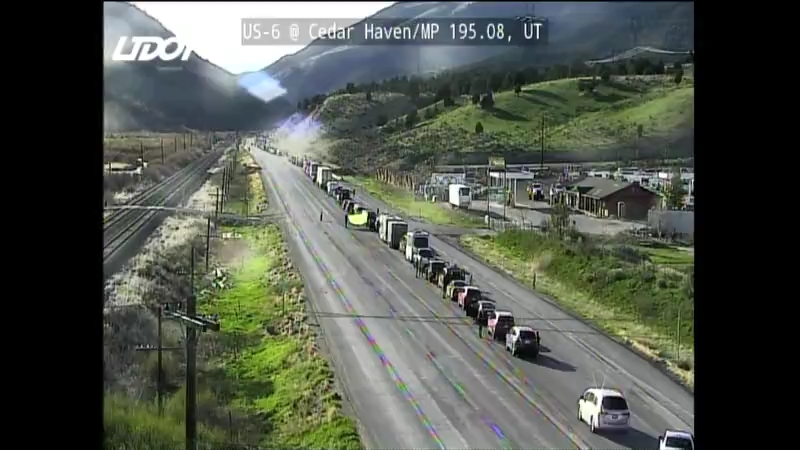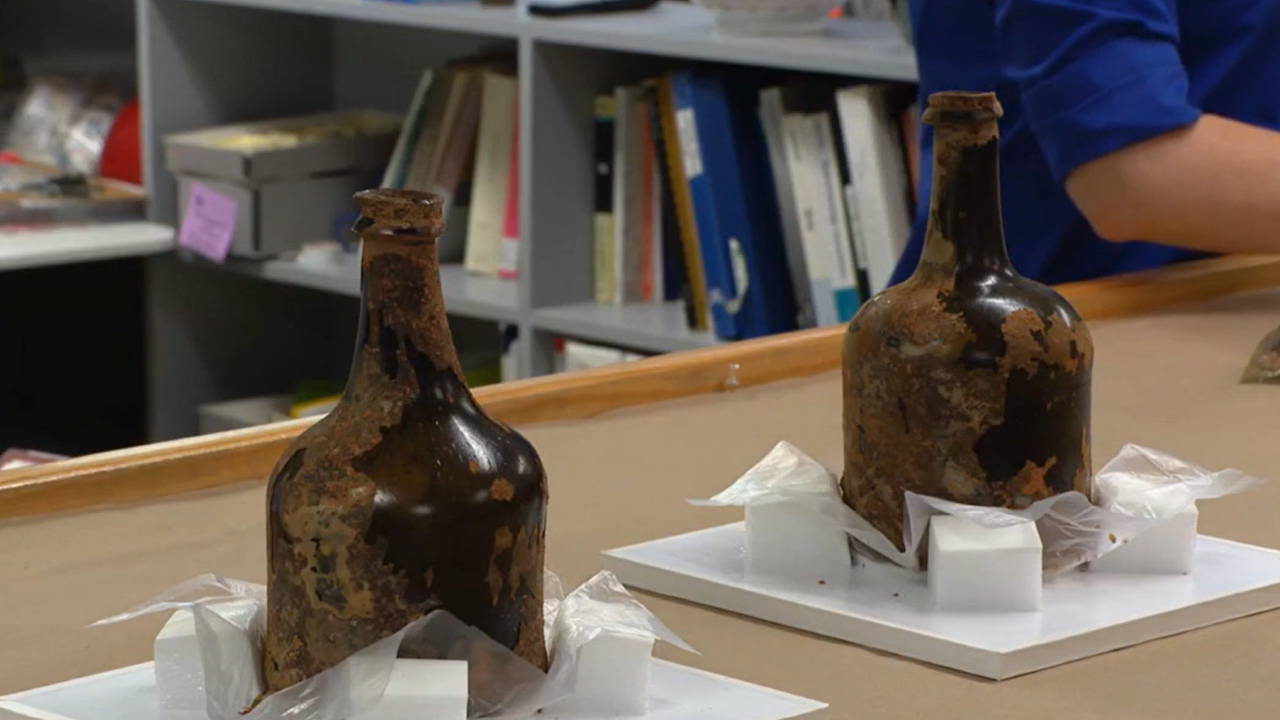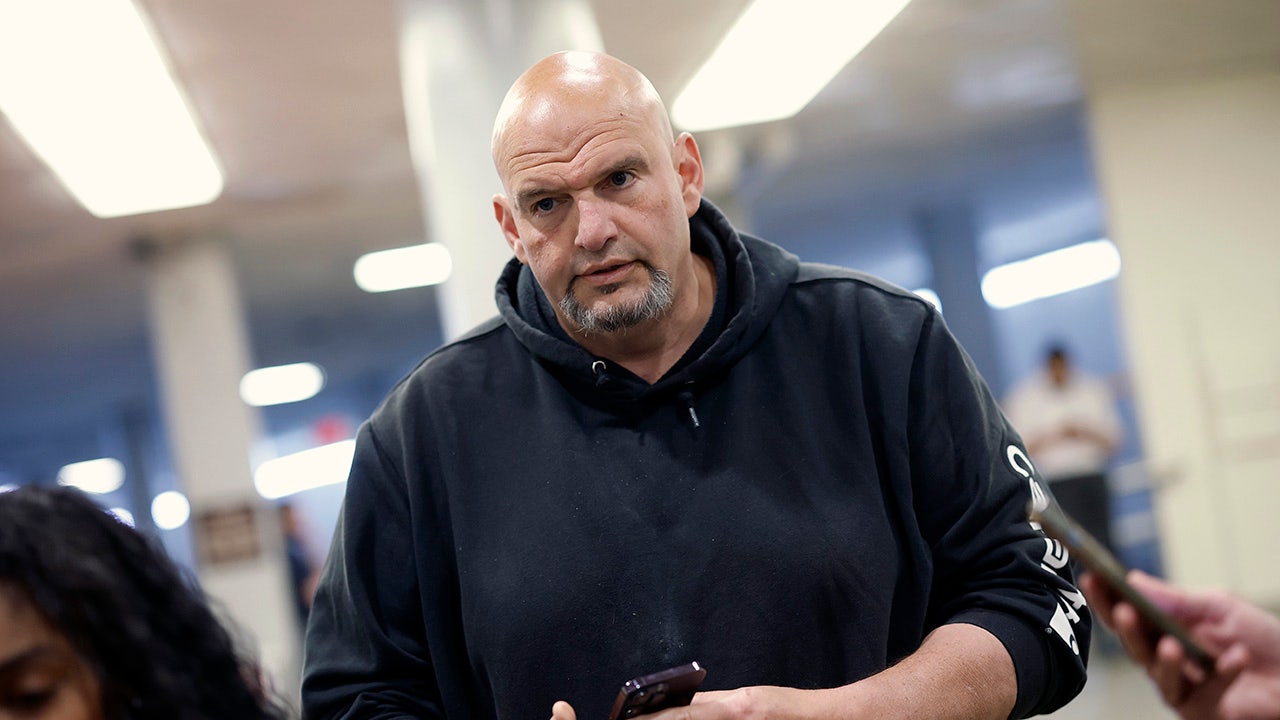Business
Storied presses print L.A. Times for the last time as production moves to Riverside

The swing shift is about to start at a plant that is about to close. Late winter sunlight casts long shadows from workers crossing the parking lot, where stray cats skulk among the cars.
Only two weeks left, and the routine is unchanged: clocking in at 5 p.m., heading to the locker room, trading street clothes for work wear. If anyone feels sadness or loss, no one shows it. They have a newspaper to put out.
“We’re trying to do this with a little class and dignity,” said shift supervisor Kal Hamalainen.
Sixteen months ago, they were told that the Los Angeles Times, their employer, would outsource the printing of the paper and that the Olympic printing plant, once a crown jewel in a vast media empire, would shut down sometime in 2024.
Pressman Mike Carper reviews newspapers at the press console at the Olympic plant.
(Genaro Molina / Los Angeles Times)
The decision was set in motion many years earlier when the Chicago-based Tribune Co., then owner of The Times, sold its historic properties, and The Times became a tenant.
Now, six years after Dr. Patrick Soon-Shiong bought The Times in 2018, the lease on the Olympic plant is expiring, and paying rent has become untenable. The paper will be printed in Riverside by the Southern California Newspaper Group, with its circulation numbers remaining the same.
“Technology and economics have changed dramatically, and we’re transitioning to a new era for our business,” Times President and Chief Operating Officer Chris Argentieri said in a statement, citing both the daily newspaper and digital platforms.
March 10 will be the last run of The Times at the Olympic plant.
Dressed in blue pants and blue shirts with a Times eagle patch, the workers find their places throughout the sprawling facility. Each is a crucial link in a chain of production often called the daily miracle: that alchemical transformation of words and pictures into a newspaper to be held, sold, mailed or tossed onto any driveway, any doorstep in the city.
What once was so easy to take for granted has never seemed so remarkable.
They have watched as their crews have been cut, three shifts reduced to one. They once printed other papers besides The Times, and those have gone elsewhere. But it’s hard to be nostalgic over what seems inevitable.
Newspapers have suffered many depredations over the years, from the internet to cost-cutting shareholders to skepticism and disinterest in the written word. With print readership declining in most markets, many media outlets are publishing stories online before printing them. The Times is following this trend, though it consistently ranks among the six largest newspapers in the country for print circulation.
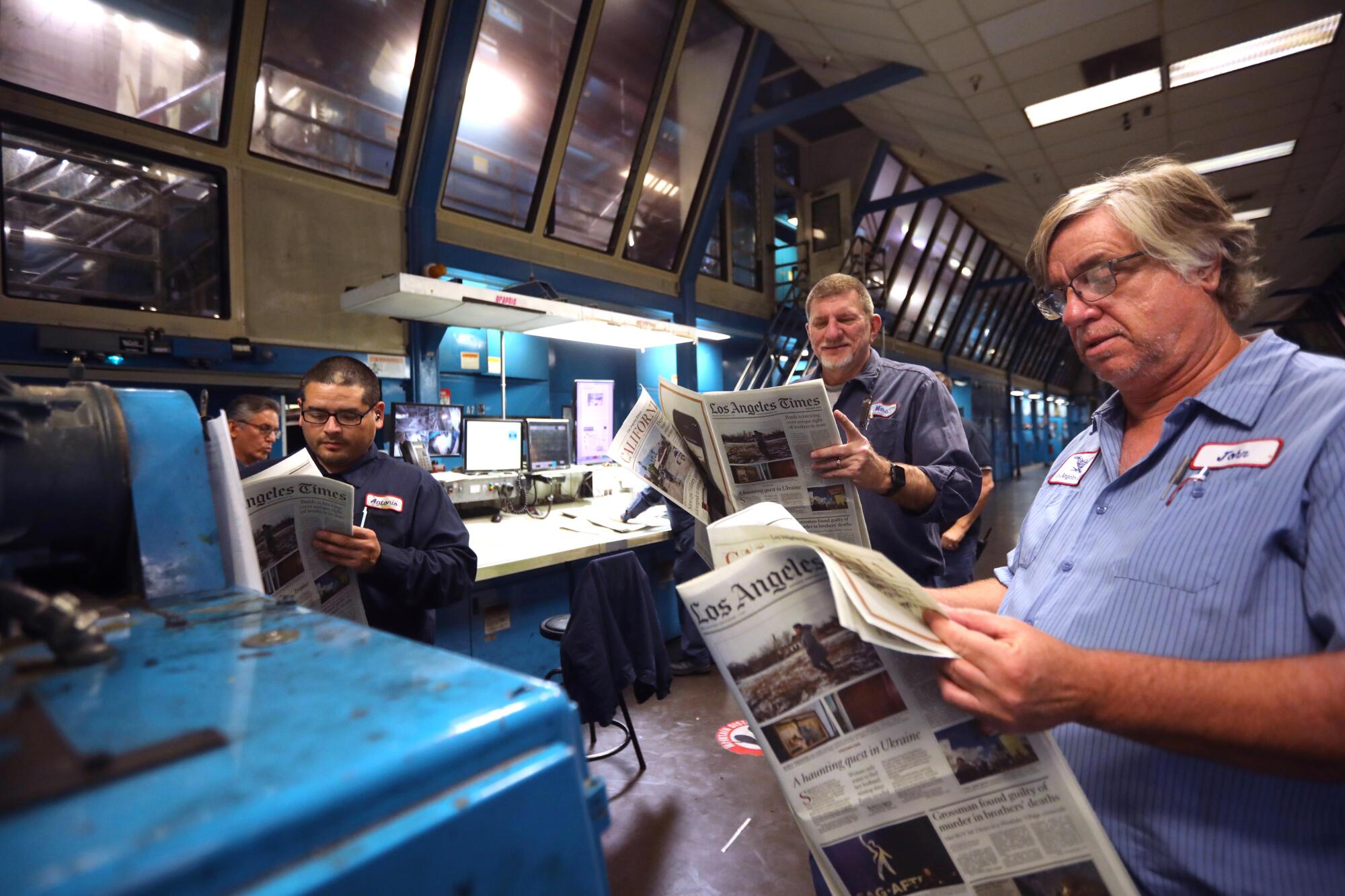
At the Olympic plant, pressman Antonio Garcia, from left, press operator Marc Strong and pressroom supervisor John Wenzel review newspapers to make ongoing adjustments of color and to check whether everything is in register.
(Genaro Molina / Los Angeles Times)
But that’s another story. On this Friday night, Feb. 23, what’s more important is a Ukrainian woman’s search for her husband, a jury’s verdict in a hit-and-run, and in sports, a profile of UCLA’s mercurial basketball coach, as well as the obituaries, comics and horoscopes.
Press operators gather to review the run: Tomorrow’s paper will have color on all but one of the 22 pages. They’ll start at 8:30, print a little more than 100,000 copies and be done in less than two hours.
To step inside the Olympic printing plant is to step inside a time capsule enshrining a 19th century product manufactured with 20th century technology and poised for 21st century obsolescence.
Within these walls was the future of Los Angeles and Southern California, as once imagined by the owners of The Times. Fueled by a diverse economy — a dividend of the postwar boom years — this building, likened by one manager to the Taj Mahal, was dedicated on March 6, 1990. (The paper had been printed on the company’s aged presses in the basement of its headquarters downtown.)
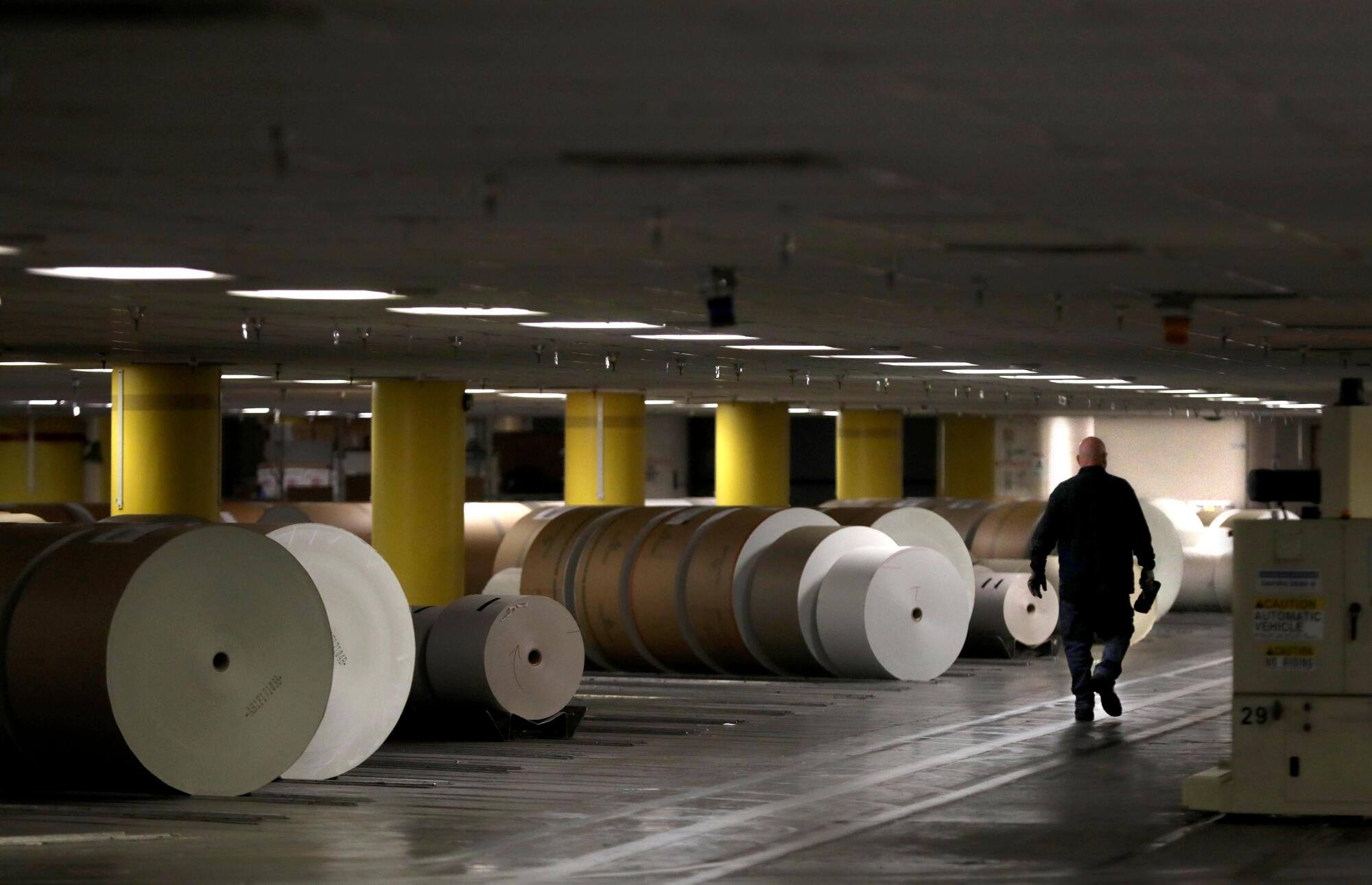
Material handler Gary Cook makes his way past the last few remaining rolls of paper that will be used to print the final editions of the Los Angeles Times at the Olympic plant.
(Genaro Molina / Los Angeles Times)
“This was to be a model for the world, not just Southern California,” said Tom Johnson, 82, publisher from 1980 to 1989.
It cost $230 million, the lion’s share of a nearly half-billion-dollar expenditure that saw the construction of a printing plant in Chatsworth and the renovation of an existing production facility in Costa Mesa. Those were halcyon days for The Times, whose revenue in 1991 topped $3.7 billion.
“Come visit the 21st century,” Times readers were encouraged in an advertisement inviting them to tour the new Olympic plant.
Its story was told by numbers: a 26-acre site; a 684,491-square-foot building; six presses capable of printing 70,000 96-page papers per hour; a 400,000-gallon underground water tank for fire suppression; six 6,200-gallon tanks of color ink; a warehouse capable of holding a 65-day supply of paper; and a 148-seat cafeteria for nearly 500 employees.
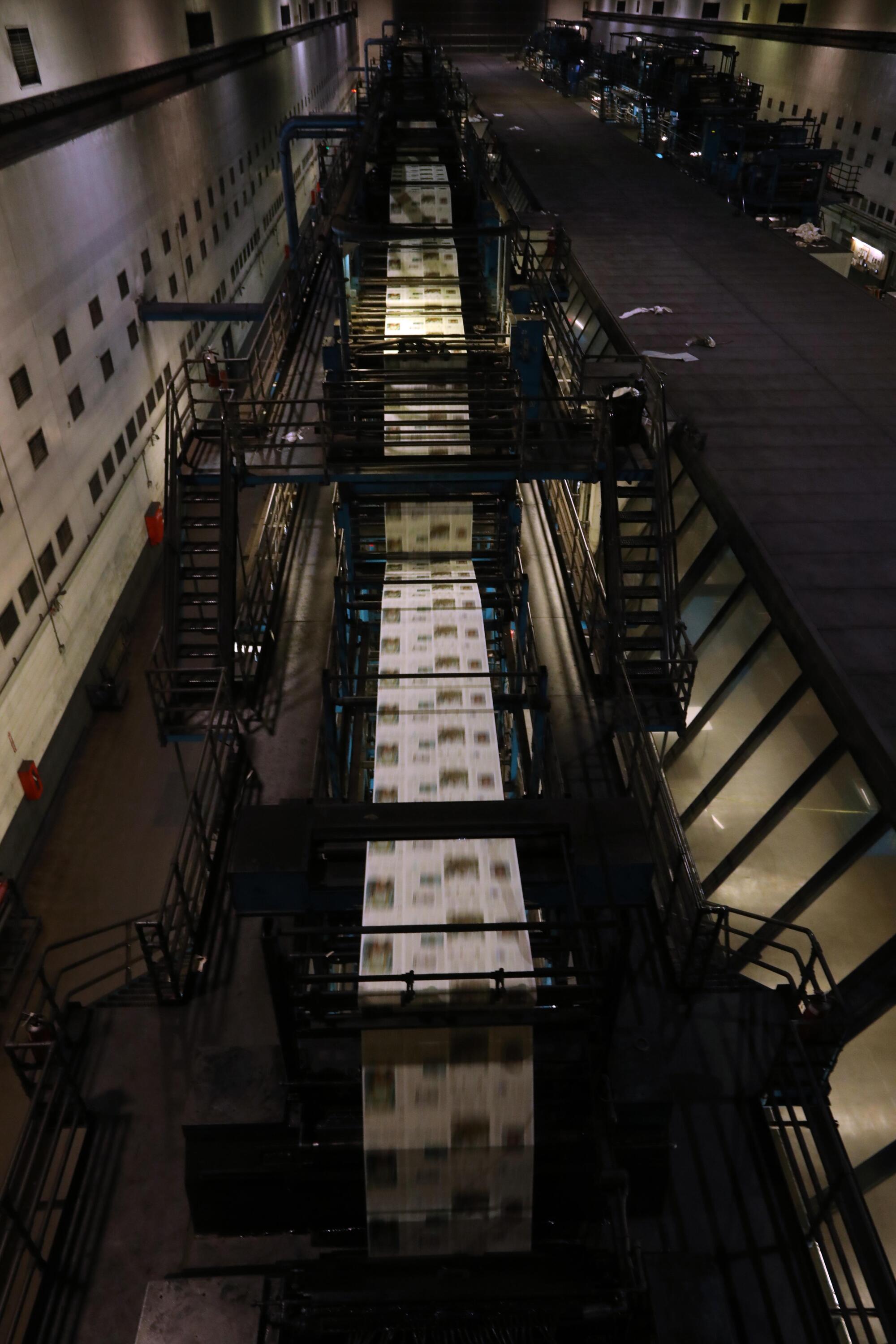
A view from the catwalk captures newspapers rolling off the presses at the Olympic printing plant.
(Genaro Molina / Los Angeles Times)
Beyond the numbers was the Jetsons quality of the place.
Robotic vehicles delivered rolls of paper from the warehouse to machines that fed the presses. Doors opened at the push of a button. Conveyors whisked printed papers to automated bundlers and then to awaiting pallets, hands free.
At the center of it all were the six presses, three on one side and three on the other, running almost two football fields long, connected by a nearly soundproof room with windows angling overhead, providing press operators with easy line of sight and silent escape from the incessant 100-decibel thrum.
The lobby, as elegant as an art museum, was finished in marble and hardwood and featured a glass wall, three stories tall, overlooking the presses that receded far in the distance. In the floor lay a time capsule, a measure of the owner’s faith in the future, to be opened on the paper’s bicentennial: Dec. 4, 2081.
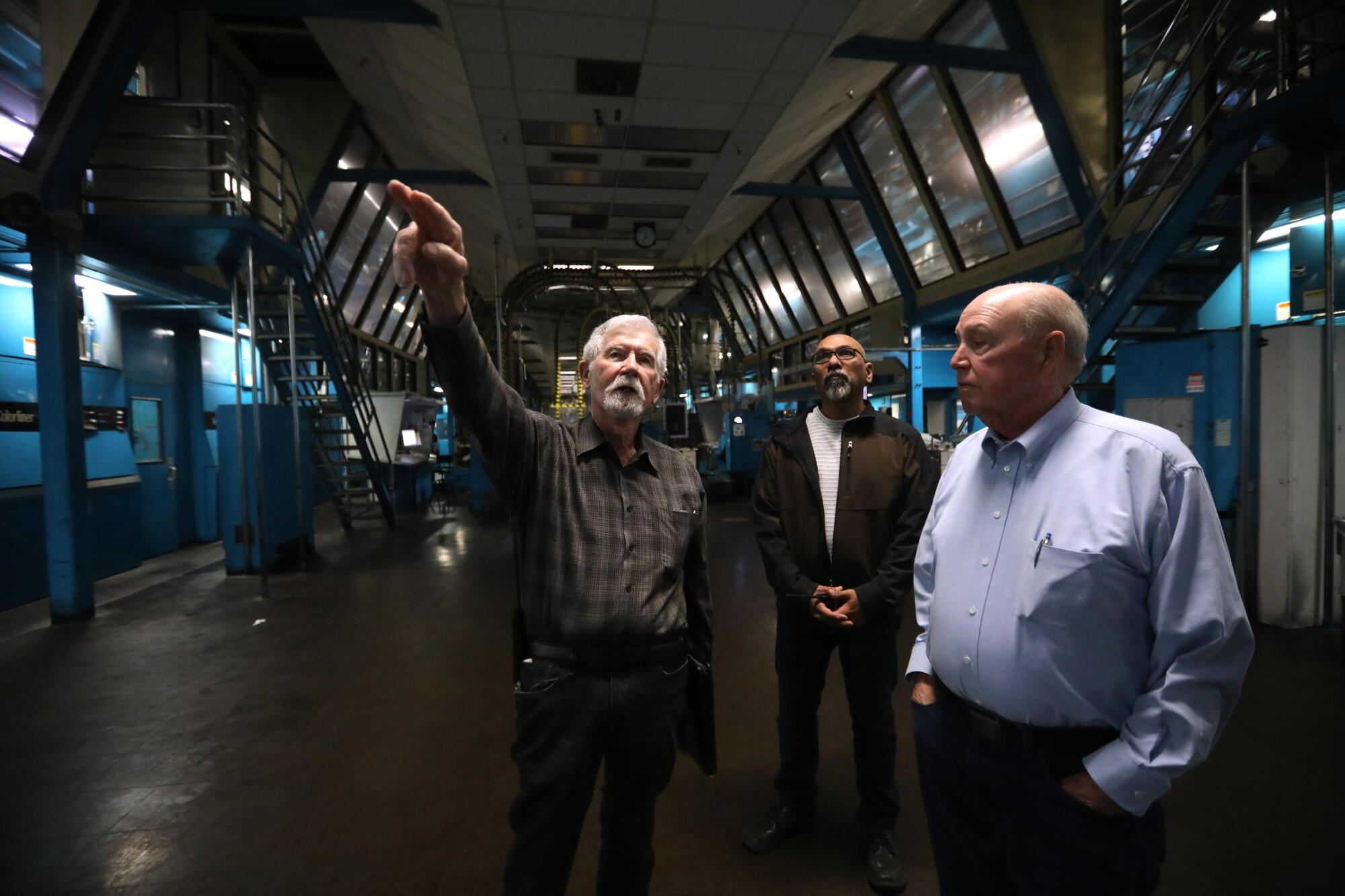
Retired press superintendent Bob Lampher, left, retired pressroom manager Jack Boethling, right, with packaging manager Durga Bhoj, recall the days when they worked in a thriving pressroom while visiting the Olympic plant.
(Genaro Molina / Los Angeles Times)
Bob Lampher came to work at the Olympic plant in 1989 as the presses were being installed. He had started at the Times 22 years earlier, “a dream job” after working the presses for the Anaheim Bulletin, the Downey Southeast News and the Costa Mesa Daily Pilot.
“Oly” — as the plant was known — “was the most modern pressroom around,” said Lampher, 82, a retired superintendent. “When I first got here, my jaw dropped. It was simply beautiful, and I thought it would run forever.”
The assumption is forgivable. The Times’ weekday circulation — spread among the Olympic plant, as well as Orange County and the San Fernando Valley printing facilities — was 1.2 million; 1.5 million on Sundays. (Today, success is measured by digital subscriptions, currently close to 550,000.)
To meet that printed volume — for a newspaper so filled with advertising that it ranged from 100 to 200 pages daily (on the Sunday after Thanksgiving 1993, the paper was a whopping 592 pages) — managers choreographed a round-the-clock dance that pushed newsprint through the presses at nearly 30 mph, resulting in close to 60,000 papers printed in an hour.
The sound was like a thundering locomotive. Ink mist and paper dust flew through the air. Margins of error were unforgiving.
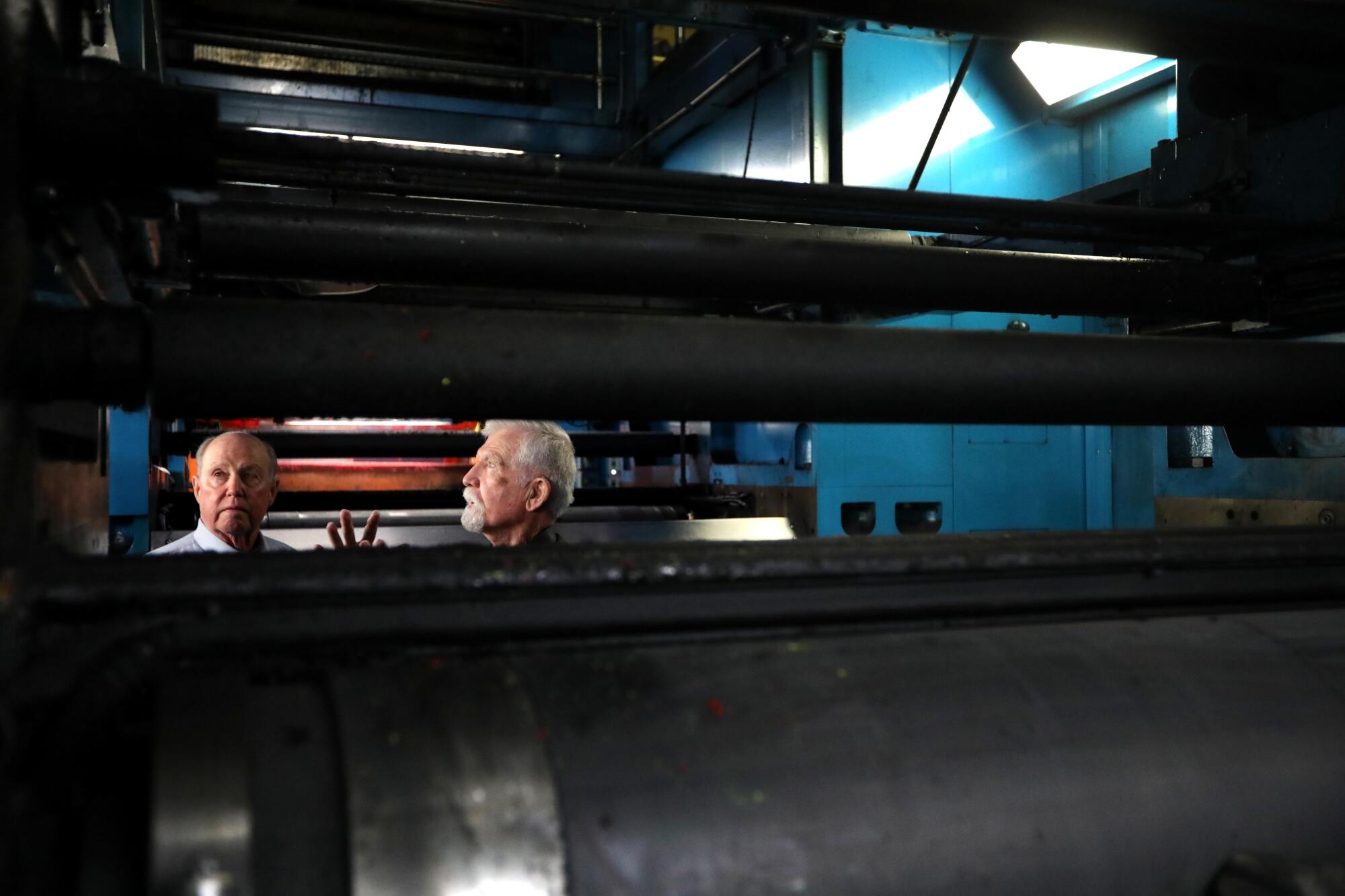
Retired pressroom manager Jack Boethling, left, and retired press superintendent Bob Lampher are framed by rollers of a printing press while walking through the Olympic printing plant.
(Genaro Molina / Los Angeles Times)
“When you’re doing it, it boggles the mind,” said Lampher, who left The Times in 2002. “I would go back tomorrow just to hear those presses running again.”
His buddy and former press room manager, Jack Boethling, 77, understands. “When you get ink in your veins, there’s nothing like the roar of the presses going at full speed.”
As the swing shift gets underway, Emmett Jaime pries inked plates off cylinders. A Dead Kennedys song plays on a radio boom box, as a bell rings a brief warning each time a cylinder turns.
Jaime, 56, plans to take a little time off before looking for another job. He’d like to work eight more years, but he followed his father to The Times when he was 19 and knows only this world.
John Martin, 60, sits at an operator’s console, studying a copy of a real estate section, whose advertiser is known to be especially picky. He’s making sure the columns of type and photographs sit squarely on the page with equal margins top and bottom.
“It’s been a great, great, great, great run,” he said, describing his 43 years with The Times. When he started, his seniority number was 380. He had hoped one day to make No. 1 but is satisfied to be No. 22.

Pressroom supervisor Kal Hamalainen walks through the paper warehouse that was once a thick forest of rolls stacked five high to the ceiling but is now almost empty.
(Genaro Molina / Los Angeles Times)
In the paper warehouse, Marcus Arnwine, 64, takes a quick inventory of the newsprint. Once a thick forest with rolls stacked five high to the ceiling, it is now a small glade as stock runs low.
“I’m going to miss the wealth of knowledge in this place,” said Arnwine, who started here when he was 20. “There was always someone here who knew something you needed to know.”
Neither Martin nor Arnwine is certain what their next step will be, whether to look for work or retire.
Later that evening, Adam Lee is in the plate room imprinting digital files, produced by editors and page designers, onto aluminum sheets. The air, bathed yellow by safe lights, smells of photographic chemicals and is filled with a rhythmic clicking and a shuttling swoosh.
Lee, 46, is one of the few who has a new job lined up. He started here 18 years ago, joining his stepmother and his uncle, as well his father, who put in 47 years before retiring.
His story is a familiar one: a pressroom of multigenerational employees banking on good benefits, good income and challenging work.
“When we first started,” Hamalainen said, “it was common for an old-timer to take a new hire aside and say, ‘Well, kid, you’ll have a job for life.’ ”
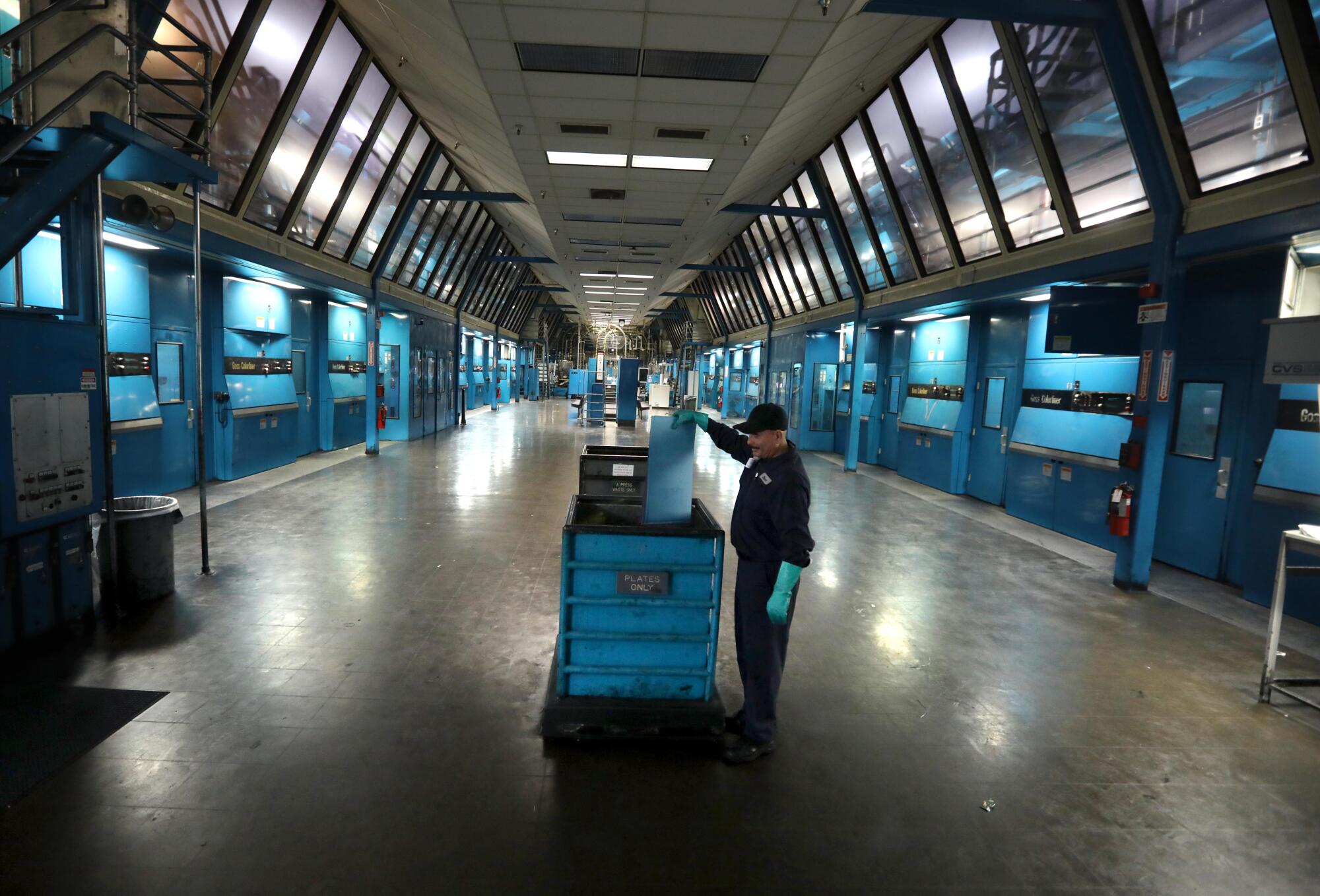
Pressman Sam Pulido ends each night of his shift by depositing the plates stripped from the presses into a bin.
(Genaro Molina / Los Angeles Times)
Today in the building’s growing emptiness, they are still a community kept close by their commitment to that work, proud of their craft and eager to dazzle visitors with technical explanations of a job that took years to master: the speed of the paper, the proportions of water and ink, the ability to make a fix on the fly.
They knew there were risks. Some lost fingers in the presses or wrenched knees working on the floor. Some lost marriages to the strain of an unforgiving schedule.
As often as they held history in their hands — the Gulf War, 9/11, the invasion of Iraq, the death of John Wooden, of Kobe and the pandemic — the work never allowed lingering, and they never missed a deadline.
They lived by the clock and by schedules defined by the vastness of Southern California. They had to know when to finish a run to make a 6 a.m. delivery to Santa Barbara, San Diego, Palm Springs.
“Old news doesn’t sell,” Lampher said.
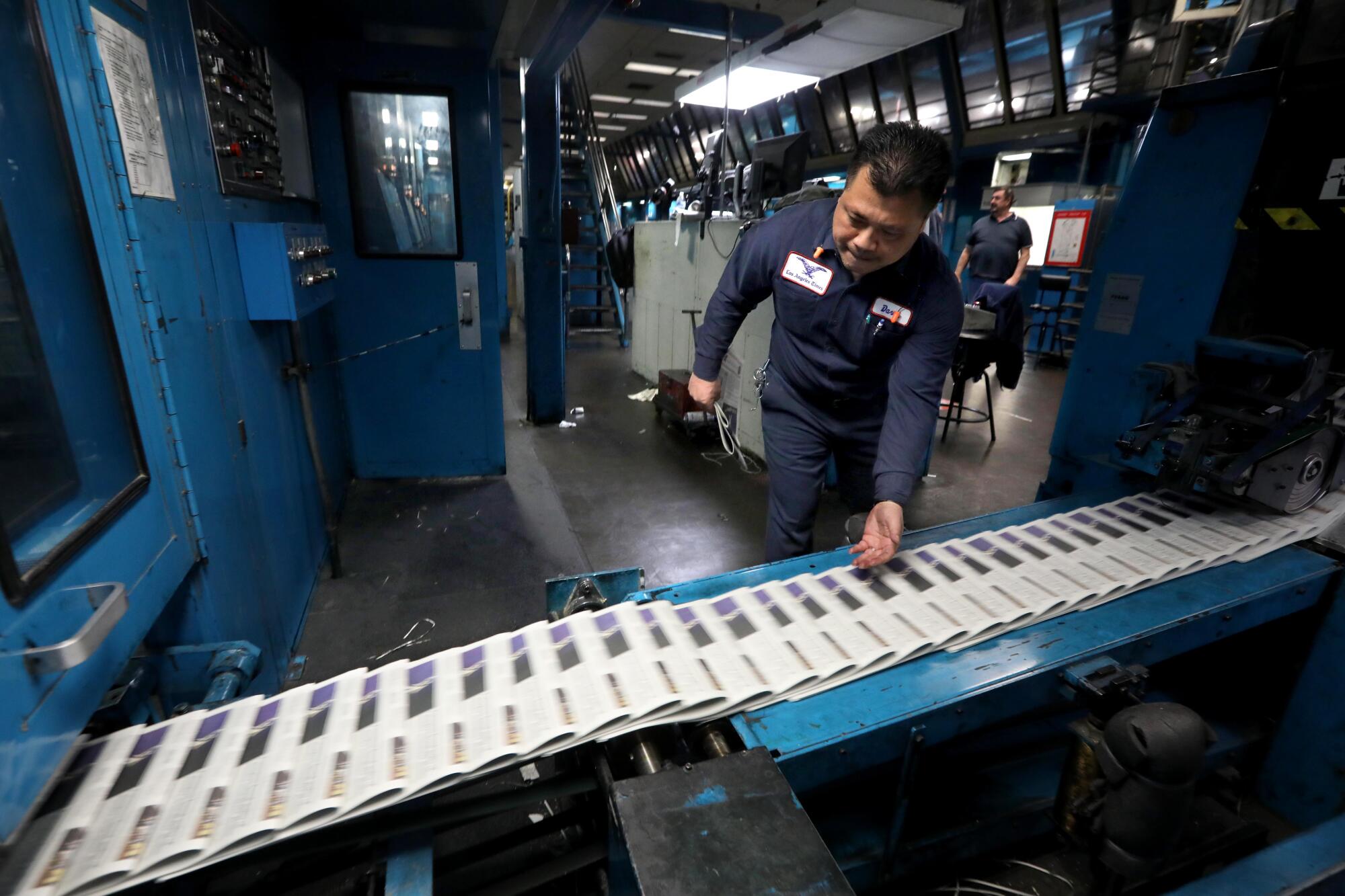
Ink specialist David Oma prepares to pull a newspaper from the conveyor belt to make sure the ink density is proper, the color is in registration, the margins are set, and the date is accurate.
(Genaro Molina / Los Angeles Times)
By 8:44, the presses are rolling at a modest clip. Crews grab from the conveyor early copies being sidelined as waste. They thumb through pages to make sure the ink density is proper, that the color is in registration, the margins are set, pagination perfect, date accurate.
They make refinements and by 9:15 set the throttle to a full gallop, 45,000 papers an hour. Overhead, the newsprint whips by in a blur, running through a succession of cylinders inked cyan, magenta, yellow and black, before converging into a central machine that folds and cuts it into individual papers.
They feel that familiar thrum in their chests. They breathe the moist, almost humid air, and still marvel that such brutish machinery can produce such delicate results.
“It’s like an NFL player who can also be a ballerina,” Hamalainen said. “There is so much strength, power, endurance and finesse in this equipment.”
They find it hard to believe that once they are done, the presses will be dismantled and sold for scrap. The building and the property will be turned into movie and television production studios, said a spokesperson for the owner, Atlas Capital Group.

Pressman Sam Pulido reviews newspapers at the Olympic printing plant, where the L.A. Times will stop being printed as of next week.
(Genaro Molina / Los Angeles Times)
Then at 10:31, the pitch of the whirring presses begins to drop as they slow, soon coming to a stop with 107,481 copies printed.
A few minutes later, a voice comes over a loudspeaker: “No finals.”
And they are done. A conveyor clatters as the last papers are carried to the bundlers. The first delivery truck has already left. The last truck will leave at 12:45 a.m.
The swing shift now scatters. Some of the crew strip plates off the presses. Some sit back and read tomorrow’s news, eschewing The Times’ website for the printed paper. A few head to the cafeteria to watch a movie on their phones or to the fitness room for a few reps before heading home.
The witching hour has begun, a disquieting moment for them to have nothing to do. Usually, they’d be cleaning presses and getting ready for another run, but today such diligence doesn’t make much sense.
Hamalainen steps out onto the balcony where some of the crew has gathered.
From this vantage, the Olympic plant has always felt vital to Los Angeles. Two miles away, the skyscrapers of the financial district light up in the night sky, windows glowing against the darkness. City Hall glows blue and yellow in honor of Ukraine on the second anniversary of the war. Distant sirens and horns and the whoosh of the nearby freeway provide the accompanying pulse.
They speak easily among themselves, their emotions masked by familiar banter, old memories and pride.
“It used to be that the quietest time was Sunday morning,” said Hamalainen, once the week’s final run completed at 2:30 a.m.
“Yeah, and in those days, Macy’s was the big advertiser,” said pressman Joaquin Velazquez, 65. He started working at the Olympic plant in 1984. “Remember that? Now, maybe there will be one ad.”
“Used to be a 16-pounder on Black Fridays.”
“Yep, and more than a million papers every day.”
They know they’re running on habit and adrenaline. They know there will be a bit of a freefall once they’re done.
“They’re hiring at the Arizona Republic and the Bay Area News Group and the Las Vegas Review-Journal,” Hamalainen said. “There’s work, but you have to be willing to move away.”
Velazquez draws on his cigarette. Soon, he will no longer be commuting four hours a day from his home in Eastvale.
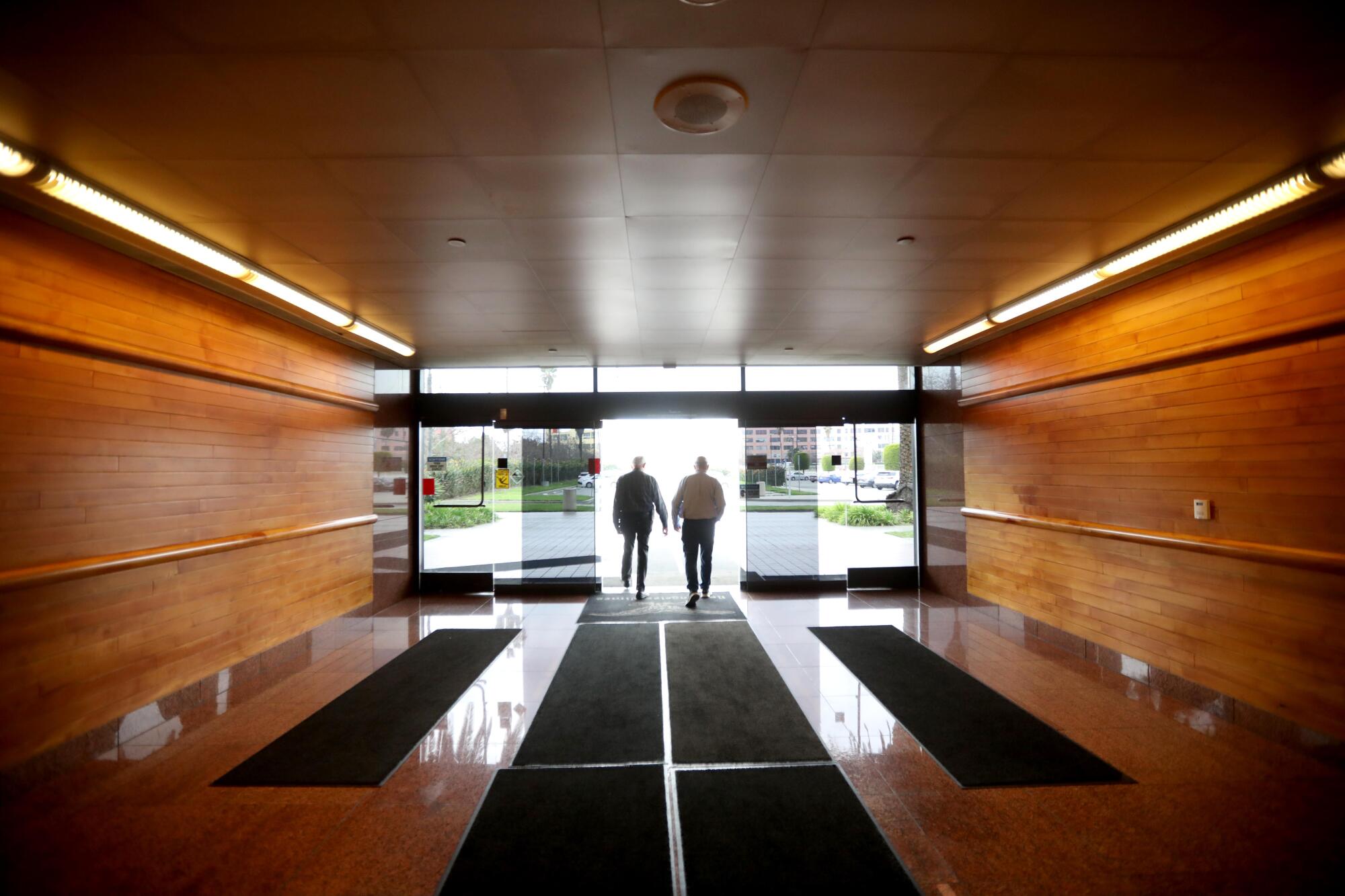
Retired press superintendent Bob Lampher, left, and retired pressroom manager Jack Boethling walk out of the Olympic printing plant for the last time.
(Genaro Molina / Los Angeles Times)
“It’s sad to see it come to an end like this, but we’re blessed to hit the finish line,” Velazquez said.
“You know, I think I’m going to sneak back in, just to see it all cleared out,” Hamalainen said. “This is going to be one big empty building.”

Business
Angelina Jolie blames Brad Pitt’s NDA for scuttling winery sale, alleges abuse before plane altercation

Angelina Jolie’s legal team filed a motion Thursday to acquire Brad Pitt’s communications stemming from an “all-encompassing” nondisclosure agreement he wanted that purportedly tanked the sale of his ex-wife’s share of their Chateau Miraval winery to him.
The former Hollywood power couple’s protracted legal dispute over the winery — and its legacy for their six children — took another turn as Jolie’s team asked a judge to compel Pitt and his company, Mondo Bongo, to produce documents pertaining to his calling for a “more onerous NDA” in order to purchase Jolie’s share of the south-of-France winery.
The documents Jolie seeks, according to the Thursday filing in Los Angeles County Superior Court, are “highly relevant” and also likely to yield admissible evidence in the case, her team argued.
Her attorney, Paul Murphy, also accused the “Once Upon a Time … in Hollywood” Oscar winner of “unrelenting efforts to control and financially drain” Jolie, as well as “attempting to hide his history of abuse, control, and coverup.”
An attorney and a publicist for Pitt declined to comment Thursday on the new filing and allegations of prior abuse.
Pitt has accused Jolie and her company, Nouvel, of secretly selling her share of their winery and family home to “seize profits she had not earned and returns on an investment she did not make.” He claimed in a February 2022 lawsuit and subsequent amended complaints that his investment in the business “exceeded Jolie’s by nearly $50 million” and that Jolie had reneged on exclusive buyout negotiations they had agreed on in early 2021, when she originally said she wanted out of the business.
Pitt has been seeking a jury trial and the undoing of Jolie’s October 2021 sale to the Tenute del Mondo wine group, a subsidiary of the Stoli Group.
In October 2022, Jolie filed a cross-complaint that argued that the couple had no agreement regarding two-party consent to the sale of either party’s interest in the property. She also detailed allegations of abuse that prompted her to file for divorce from Pitt in 2016, ending their two-year marriage and much-talked-about 10-year romantic relationship. (The actors, although legally unmarried since 2019, have not yet finalized their drawn-out divorce.)
The “Inglourious Basterds” star has also complained that he can no longer enjoy his private residence in France, as it is now co-owned by strangers; Jolie contended Thursday that she and their children have not returned to the French estate since leaving it and boarding the fateful September 2016 flight that precipitated Jolie filing for divorce five days later.
In Thursday’s motion to compel, reviewed by The Times, attorneys for the “Girl, Interrupted” Oscar winner asked again for responses from Pitt to help them figure out his reason for pulling out of their implied agreement for him to buy Jolie’s stake in the winery. Pitt’s decision to pull out of the sale, her attorney said, “nearly broke” Jolie.
“If that sale had been completed, this lawsuit never would have happened. But at the last minute, Pitt ‘stepped back’ from his agreement to buy Jolie’s interest in Miraval, and the deal collapsed. The question at the heart of this case — and at the center of this motion — is why,” the motion said.
The answer, her attorney said, has to do with sealed documents Jolie submitted in the ex-couple’s separate but simultaneous custody dispute. The new filing referred to sealed March 2021 documents — titled “Testimony Regarding Domestic Violence” — that “apparently enraged Pitt” and led to him “stepping back” from the sale.
“When Jolie filed the evidence in the custody suit, she was careful to file it under seal so that no member of the public could see it. But Jolie’s sealed filing, which included emails, summaries of the family’s expected testimony, and other evidence, caused Pitt to fear that the information could eventually become public,” the document said.
Pitt then decided he could no longer rely on Jolie’s voluntary efforts to keep things private and demanded that she “contractually bind herself to that silence,” her filing said.
With that, her team indicated there was abuse of Jolie that predated the contentious 2016 private-plane flight. In referring to that sealed filing in the custody case — as well as another titled “Testimony of Minor Children” — her team argued that Pitt tried to force a more sweeping NDA on Jolie to conceal his alleged “personal misconduct, whether related to Miraval or not.”
Her team is seeking Pitt’s communications with the FBI, U.S. attorney’s office, the L.A. County Department of Children and Family Services and the Los Angeles Police Department regarding the private flight. She is also seeking information from DCFS about its investigation, drug and alcohol testing and a safety plan the agency purportedly required Pitt to undertake to address his conduct.
“While Pitt’s history of physical abuse of Jolie started well before the family’s September 2016 plane trip from France to Los Angeles, this flight marked the first time he turned his physical abuse on the children as well,” the new motion states.
According to an exhibit on a 2024 court declaration by Jolie attorney Murphy, an offer to turn over many of the communications requested by Jolie’s team was rejected last month by attorney Stella Chang, who told a Pitt attorney via email that his “proposal does not come anywhere close to providing the documents responsive to [the team’s requests], which Ms. Jolie needs to defend herself from Mr. Pitt’s frivolous allegations.”
Pitt was never charged in connection with the plane incident, either by the U.S. attorney’s office or the Department of Children and Family Services, which investigated the incident — and its allegation of child abuse — before the FBI got involved. The FBI decided in November 2016 to close its probe without filing any charges against the actor. People magazine reported that he was drunk during the incident, which “escalated more than it should have,” and asserted that “no one was physically harmed.”
Jolie never pressed charges, the filing said, “as she believed the best course was for Pitt to accept responsibility and help the family recover from the post-traumatic stress he caused.” It also alleged that Pitt refused to seek domestic violence counseling.
Pitt, in a 2017 GQ interview, admitted he had a drinking problem — saying, “I was boozing too much” — but said he was now sober. He said he was going to therapy after first going through two therapists who didn’t work out, and lamented his and Jolie’s marital woes being dragged out and misconstrued by the media with no “delicacy or insight.” Pitt has never argued that his behavior on the 2016 flight was acceptable.
His legal team said in a June 2023 court filing that while Jolie had backed out of the winery sale, purportedly over “restrictive language” requested in a mutual nondisclosure agreement, a year later she proposed an even broader NDA in their divorce case that would have required that “[o]ther than in court pleadings or testimony, neither party shall directly or through a party’s representatives make in a public forum any derogatory remark about the other party.”
The “Thelma & Louise” actor alleged in court documents that Jolie decided to sell her Miraval stake to the Stoli subsidiary after receiving an “adverse custody ruling” in their protracted divorce proceedings.
Pitt’s legal team last summer claimed that Jolie “vindictively” sold her stake in the winery behind his back and alleged that she “sought to inflict harm on Pitt,” subsequently revealing more details about the unraveling of the couple’s relationship. Jolie’s camp at the time insisted — and continues to do so in the new filing — that Pitt refused to complete a Miraval sale with Jolie “unless she agreed to being silenced” about his alleged abuse.
Now her team is claiming that Pitt attempted to cover up the alleged abuse by objecting to the children testifying on their custody preferences. The filing includes a May 2021 text message from Jolie to a friend (as an exhibit) relaying that she tried to sell the winery to Pitt per their agreement but that he was “really not being fair” and demanding “a lot of punishing restrictions.” The filing also outlined for the first time the language of the “more onerous NDA.”
Said restrictions, per the motion, were put forth in an “expansive” NDA that stated that the parties could not make any statements or take actions that would “disparage, defame, or compromise the goodwill, name, brand or reputation of Miraval Provence or any of its affiliated or direct and indirect shareholders,” including Jolie, Pitt, Pitt’s business partner and good friend Marc Perrin, and Familles Perrin SAS.
It also stated that the parties could not “commit any other action that could likely injure, hinder or interfere with the Business, business relationships or goodwill of Miraval Provence, its affiliates, or its direct and indirect shareholders.” Jolie refused to sign it, and “by June 3, 2022, the deal was dead,” the motion said.
Pitt’s NDA in the failed winery deal would have required, according to 2023 court documents filed by his legal team, that “[a]t no time for a legally binding period of four (4) years following the Closing Date, and, on a good faith basis, any period thereafter, shall the Parties (i) make any statements, or take any other actions whatsoever, to disparage, defame, or compromise the goodwill, name, brand or reputation of Miraval Provence or any of its affiliates or direct and indirect shareholders,” including Jolie, Perrin, Familles Perrin SAS and Pitt, who has been the celebrity face of the winery, so as not to hurt or hinder the business.
Jolie accused Pitt of gaslighting her and, according to the new documents, signed a power of attorney at that point authorizing her European lawyer, Laurent Schummer, to take over the sale process.
“Mr. Pitt refused to purchase Ms. Jolie’s interest when she would not be silenced by his NDA,” Jolie attorney Murphy, managing partner at the law firm Murphy Rosen LLP, said Thursday in a statement to The Times.
“By refusing to buy her interest but then suing her, Mr. Pitt put directly at issue why that NDA was so important to him and what he hoped it would bury: his abuse of Ms. Jolie and their family. After eight months of delays, this motion asks the Court to force Mr. Pitt to finally produce that evidence.”
A person close to Jolie who was not authorized to speak publicly about the case told The Times that Pitt “is drawing all this out of Angelina.”
“She does not want to be here, she does not want to be raising any of these facts, and she is doing it only because Pitt’s lawsuit against her is forcing her to defend herself. It’s incredibly sad and she just wishes he could move on and let her be,” the person said.
The person added that Jolie’s lawyers have emails, photos and testimony that was presented under seal in the custody case that would help her in this matter. However, the person said, if the case goes to trial, she “will be forced to use that evidence in the trial whether she wants to or not.”
Times assistant editor Christie D’Zurilla contributed to this report.
Business
Federal labor investigators say L.A. poultry plant used child labor and tried to cover it up
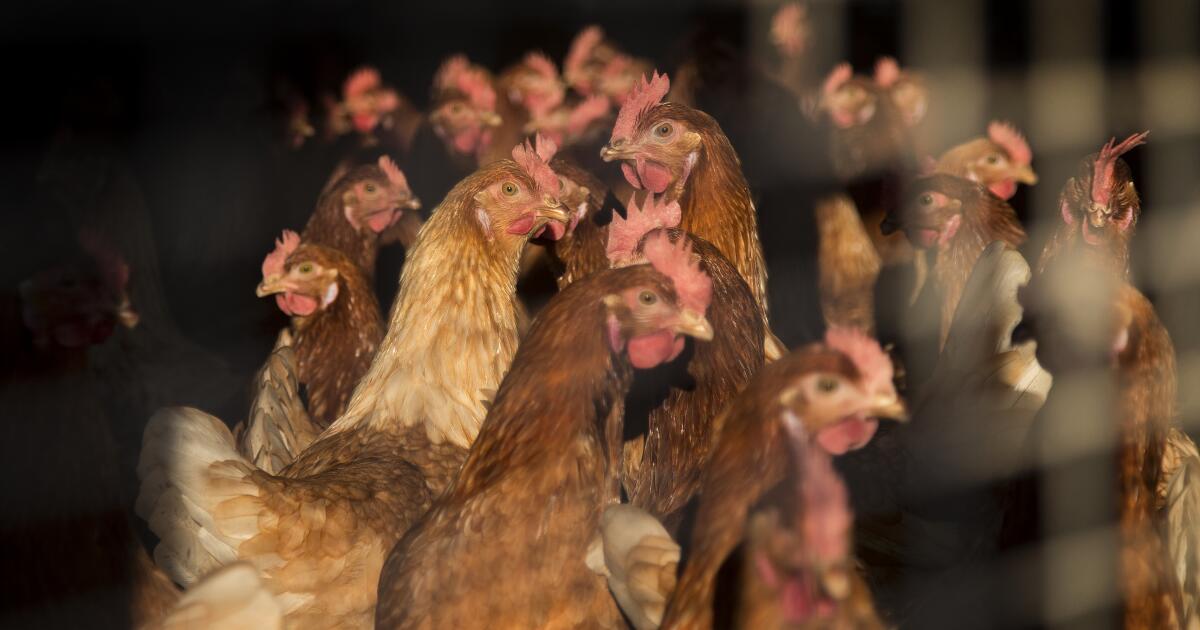
A federal judge issued a temporary restraining order on Monday to block a poultry processing plant in the city of Irwindale from using “oppressive” child labor.
The order came after investigators with the U.S. Department of Labor filed a lawsuit on Saturday alleging the poultry processor and its affiliated companies illegally employed children under the age of 18 to debone raw meat with sharp knives.
The department is seeking action forcing involved companies to forfeit money they made from selling products processed in facilities where minors were allegedly made to work in dangerous conditions.
The judge’s order involves three companies in the San Gabriel Valley — L & Y Food, Moon Poultry and JRC Culinary Group — that are all either owned, operated or managed by Fu Qian Chen Lu, who is also named in the lawsuit.
The Labor Department said in court documents that the companies continued to deliver and sell products even after agreeing to voluntarily refrain from shipping products following accusations of their use of child labor, and refused to provide information to investigators.
The companies hid 794 boxes of processed chicken and seven 1500-pound bins of chicken from investigators visiting the Irwindale facility, according to the court filings .
Federal officials and the poultry companies have presented dueling narratives of the child labor allegations.
Gregory W. Patterson, an attorney representing Chen Lu and other defendants named in the suit, accuses the Labor Department of planting an underage worker in the facility as part of its investigation, a claim the department has dismissed as “baseless.”
The crackdown by federal investigators comes as some of the country’s biggest consumer brands have come under broad scrutiny for child labor in their domestic supply chains amid revelations that children are working throughout American manufacturing and food production.
Investigators discovered children deboning poultry at the plant after visiting the facility in the city of Irwindale on Mar. 20 for a civil search warrant, the lawsuit said. Operators of the facility continued to process products, even after the Labor Department raised objections during its search warrant, in violation of federal laws prohibiting sale of products “tainted by child labor,” according to the lawsuit.
The “hot goods” provision of the Fair Labor Standards Act prohibits companies from selling products from locations flagged for child labor use in the prior 30 days.
U.S. District Judge Otis D. Wright II in his Monday decision issued a temporary restraining order requiring the businesses to stop using child labor, provide the Labor Department with information it is requesting related to its investigation, and refrain from shipping any poultry from facilities accused of employing child labor.
“In light of the immediacy of irreparable harm pending the Court’s review of this action, the Court finds a temporary restraining order warranted,” Wright wrote in his order on Monday.
Barring immediate action, he said, companies named in the lawsuit “will continue to employ oppressive child labor to the risk of minors’ life and limb; hot goods may enter the stream of commerce; and Defendants will continue to thwart Plaintiff’s investigation.”
Patterson, the attorney representing Chen Lu and other defendants, said in an emailed statement that the labor department had a 17-year-old “gain employment with Moon Poultry under false pretenses by presenting a fake government identification” and “directed this person to work in a hazardous area of the Moon Poultry facility in Irwindale.”
Patterson alleged that the Labor Department aimed to manufacture a child labor claim to “strengthen its negotiating hand” in an investigation about overtime wages that had not been paid to workers.
“The defense counsel’s allegations are false. The Labor Department has previously responded to the defense counsel on this issue, but he has nevertheless chosen to press his baseless claims,” said Marc Pilotin, regional solicitor for the Labor Department, in an emailed statement.
The Labor Department has investigated other poultry processing plants in California in recent months.
In December, federal investigators found grueling working conditions at two poultry plants in City of Industry and La Puente operated by Exclusive Poultry Inc. as well as other “front companies” owned by Tony Elvis Bran.
Children as young as 14 stood for long hours cutting and deboned poultry and operating heavy machinery, the labor department said. The workers came primarily from Indigenous communities in Guatemala.
The poultry processor, which supplies grocery stores including Ralphs and Aldi, was ordered to pay nearly $3.8 million in fines and back wages.
An investigation published in early February by the Fresno Bee detailed dangerous and sometimes deadly conditions for primarily Latino immigrant workers at Pitman Farms in the Central Valley, which produces the Mary’s Free Range Chicken brand.
Business
Money Talk with Liz Weston: Managing mortgage debt in retirement

Dear Liz: My husband and I are Gen Xers who are renting. We have enough cash from the sale of our last home to make a small down payment on another. If we moved to a more affordable community, we could manage the payments, but it would still be a stretch. That scenario would not have bothered me 10 years ago, but now I’m close to 50. Is it a good idea to take on a mortgage at this point? What is the best way to ensure I can afford to keep the roof over my head when I can no longer work full time?
Answer: Having a mortgage in retirement used to be uncommon, but that’s no longer the case. The Joint Center for Housing Studies of Harvard University found 41% of homeowners 65 and older had a mortgage in 2022, compared with 24% in 1989. Among homeowners 80 and over, the percentage with mortgages rose from 3% to 31%.
The amounts owed have skyrocketed as well. Median mortgage debt for those 65 and older rose more than 400%, from $21,000 to $110,000 (both figures are in 2022 dollars). Median mortgage debt for those 80 and over increased more than 750%, from $9,000 to $79,000.
Mortgage debt doesn’t have to be a crisis if you can afford the home and the payments don’t cause you to run through your retirement savings too quickly. In fact, some retirees are better off hanging on to their loans. It may not make sense to prepay a 3% mortgage when you can earn 5% on a certificate of deposit, for example. Paying off a mortgage early also could leave you “house rich and cash poor,” with not enough savings to deal with emergencies and later-life expenses.
But the key is affordability. A mortgage that’s a stretch now might become easier to afford if your income rises, which was almost a given when you were younger. Now, however, you’re approaching the “dangerous decade” of your 50s, when many people wind up losing their jobs and failing to ever regain their former pay, according to a study by ProPublica and the Urban Institute.
Renting has its risks as well, of course. You aren’t building equity and you typically have little control over rent increases, other than to move.
For help in sorting through your options, consider talking to a fee-only, fiduciary advisor. Among the most affordable options are accredited financial counselors and accredited financial coaches, who typically are well-versed in the money issues facing middle-class Americans. You can get referrals from the Assn. for Financial Counseling & Planning Education at www.afcpe.org.
Dear Liz: I’m a CPA and getting conflicting answers from the Social Security office about a case I’m working on. Both clients are 70 and they’re considering legal separation or divorce. She took Social Security at 62 and receives about $1,500 a month before deductions. He started Social Security at 70 and receives about $4,600. How would her Social Security change at his death or their divorce, if she doesn’t remarry?
Answer: Based on the amounts involved, both parties are receiving their own retirement benefits and those aren’t affected by divorce, said William Reichenstein, a principal at Social Security Solutions, a claiming strategy site. (If the wife were receiving spousal benefits, those would continue after divorce as long as the marriage lasted at least 10 years and she did not remarry.)
If the husband dies and they haven’t divorced, the wife would be entitled to survivor benefits equal to his full monthly benefit amount ($4,600, plus any future cost of living increases). If they divorce and the marriage lasted at least 10 years, she also would be entitled to his full amount. Remarriage wouldn’t affect her divorced survivor benefit since she’s over 60, Reichenstein said.
Liz Weston, Certified Financial Planner®, is a personal finance columnist for NerdWallet. Questions may be sent to her at 3940 Laurel Canyon, No. 238, Studio City, CA 91604, or by using the “Contact” form at asklizweston.com.
-

 Kentucky1 week ago
Kentucky1 week agoKentucky first lady visits Fort Knox schools in honor of Month of the Military Child
-
News1 week ago
Maryland high school student arrested after authorities discovered a 129-page document detailing school shooting plan, police say | CNN
-

 World1 week ago
World1 week agoIranian media says three drones downed after explosions heard in Isfahan
-

 World1 week ago
World1 week agoShipping firms plead for UN help amid escalating Middle East conflict
-

 Politics1 week ago
Politics1 week agoIsrael hits Iran with 'limited' strikes despite White House opposition
-

 Politics1 week ago
Politics1 week agoICE chief says this foreign adversary isn’t taking back its illegal immigrants
-

 News1 week ago
News1 week agoThe San Francisco Zoo will receive a pair of pandas from China
-

 Politics1 week ago
Politics1 week ago'Nothing more backwards' than US funding Ukraine border security but not our own, conservatives say


